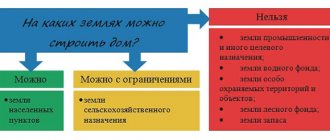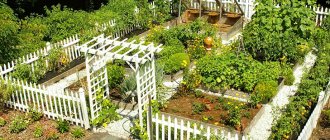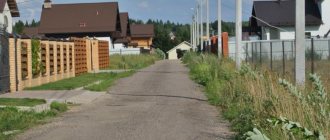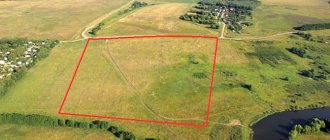When intending to purchase a plot of land, you should clearly understand what parameters it should have in order to ideally suit specific tasks: locating a house, running a subsidiary plot or creating a farm. This article will focus on the plot of private household plots as one of the most common types of land use.
What is private household plot
Private subsidiary plot (personal subsidiary plot) is a form of activity of a citizen and his family members aimed at the production of agricultural products and their processing.
In order for such activities to fall within the definition of private household plots, they must meet the following criteria:
- making a profit is not planned (this is why the activity is officially recognized as non-entrepreneurial - with all the ensuing consequences in the form of the possibility of not keeping accounting records and not paying taxes);
- there are no hired workers, all work is performed exclusively by one family (or even one person);
- products are produced for personal use, that is, to satisfy personal needs, and it is not prohibited to sell surplus products in any volume;
- the plot of land on which the activity is carried out is provided or acquired specifically for the management of private household plots and has a note about this in the documents.
Definition
The legislation does not contain a clear definition of a private plot. It follows from the Law on Private Private Farms that a plot of private household plots is a plot of land with a documented type of permitted use of the land - “for running private plots”, which was acquired and (or) provided to a citizen for running private plots.
Decoding
Lands in the Russian Federation are divided into categories, depending on their intended purpose, including agricultural lands (hereinafter referred to as agricultural lands) and lands of populated areas. The lands of each of these two categories are further subdivided according to the type of use of the land plot. The plot of private household plots is unique in that it can relate to both agricultural lands and lands of populated areas.
A plot of private household plot is called a household plot if it is located within the boundaries of a populated area, in which case the category of land is defined as “land of populated areas.” A plot of private household plot is called a field plot if it is located outside the boundaries of a populated area, in which case the plot falls into the category of agricultural land.
How to make money selling rabbits and chickens raised on private plots
Despite a number of difficulties, users of the portal successfully sell surplus meat from rabbits and chickens raised on private plots.
Desyatkina Member of FORUMHOUSE
My husband and I have a large family. The salary at the company is small and we decided to make money on our personal subsidiary plot. There is not enough land, less than 4 acres, so we thought about it and decided to breed purebred rabbits. In addition, we have chickens, guinea fowl and turkeys.
Let's consider the benefits of this business:
- It took 80 thousand rubles to buy rabbits and five cages.
- According to the user, the costs paid for themselves in about 6-8 months, and the profit from the sale of rabbits ranges from 10 to 25 thousand rubles. monthly.
Note: prices are for 2014.
Buying rabbits led to another profitable business idea, which we will discuss below.
In the meantime, we’ll tell you how Desyatkina sold rabbit meat at the fair.
Desyatkina
We decided to take part in the autumn fair. I found out that for this you need a certificate that we are private household plots. I received the certificate. We also checked how we keep rabbits. I registered as a participant and was given a pass to the fair. The rabbit meat was taken to the veterinary laboratory for testing in advance. They put stamps on the meat, and completely free of charge. My husband made a table, a sign, price tags, bought scales, an apron, arm ruffles and I went to sell.
According to the user, nothing bad happened. At the fair they only checked the documents and then needed to make honey. book.
In 40 minutes of trading, we managed to sell 5 carcasses (rabbit meat) for 3,200 rubles.
So, the beginning has been made! Now let's talk about how to raise and sell chickens from private household plots.
boch2002 Member FORUMHOUSE
I have four children and my wife and I raise poultry in private household plots. It all started with quails. My wife wanted to raise them, but then we got caught up in the process, and we approached it from a purely practical point of view - we got chickens and away we go!
You can learn a lot of interesting things about Dmitry Bocharov’s (boch2002) approach to raising chickens and see a chicken coop with homemade cages set up in the garage in this video.
Having decided to make money from private household plots, first of all you need to think about where you will sell your products. Without a reliable sales market and regular customers, the venture is doomed to failure.
The activities of boch2002 began in 2008, when the crisis struck. I didn’t want to work for my “uncle,” and Dmitry’s family decided to start poultry farming. To understand the process of raising chickens, the user got a job at one of the poultry farms in the Moscow region. In three weeks, having watched enough of the production process, Dmitry realized that he would definitely not do this. But knowledge helped me grow my business, which feeds my family.
Dmitry's farm contains several hundred birds - broilers, turkeys, ducks and about 3,000 quails.
The main question that interests users of the portal is how to sell products and how to obtain veterinary certificates for sale?
boch2002
My meat is mainly bought by regular customers and resellers. I'm not chasing volumes. Main quality. We raise poultry without chemicals. We get information like this:
- The litter is collected in a jar for 3 days.
- Then he is submitted for analysis.
- We receive a certificate that the bird does not suffer from salmonella and colibacillosis.
- We're going to the veterinary station.
- Next, inspection before slaughter, inspection after. Intestines for inspection.
- We receive a certificate.
The cost of a veterinary certificate is 1500 rubles. for 10 carcasses, which can be sold.
Those. To sell more birds you need to get another certificate! And these are additional costs. Moreover, the price is 1500 rubles. for 10 “heads” does not depend on the size/weight of the animal . A pig carcass, a chicken or a quail - all this is considered one “carcass”.
About:
- How to properly raise poultry in private household plots in a limited area.
- How to avoid bird deaths.
- Why should you start poultry farming with raising quails?
- How profitable is it to sell poultry raised on a personal plot?
- How much money is spent on feeding the birds, electricity and overhead costs.
- How to stay profitable when selling poultry meat from private household plots.
All this is described in detail in the boch2002 topic, a link to which we will provide below. The main thing is that you must truly love your business and be passionate about it, and the benefits will not keep you waiting!
Purpose
The use permitted by law depends on whether the private plot is located within the boundaries of a populated area or beyond:
- On a private plot of land, you can build a residential building and any other buildings (subject to the rules that are the same for everyone - construction, fire safety, sanitary and hygienic and others, and you can also produce agricultural products (any kind: planting plants, raising animals and poultry, setting up an apiary) In a residential building built on a private plot of land, you can register at your place of residence, and it is also possible to receive a property tax deduction.
- On a field plot of land, you can only produce agricultural products and erect non-permanent buildings for this purpose (without a foundation). It is prohibited to build a residential building, and if it is built, it may be forced to demolish it. Naturally, there is no question of registration in such a house.
Rules for keeping poultry on a private farm
To avoid the emergence and spread of infectious diseases of birds, owners of private household plots must remember the rules for keeping winged birds:
- the room where birds are kept must have slopes for drainage;
- the territory must be fenced;
- different types of birds should be kept in separate areas, in separate rooms;
- birds must be provided with free access to walking areas;
- It is not recommended to keep birds in a backyard with other animals;
- the room where birds are kept must be regularly cleaned of dirt and droppings;
- If necessary, vaccinate birds to avoid the threat of infectious diseases of birds.
Minimum/maximum size of private plot
A plot of private household plots can be provided as a property or purchased.
If the land is issued by local governments or the state, then the size of the plot (minimum and maximum) will be limited by the standards established by the local governments. Thus, in Vladimir, a plot of land from 0.04 hectares to 0.15 hectares can be provided. In the city of Cheboksary - from 1200 to 1500 sq. m. m.
One family (one private household plot) may own (or otherwise have) a limited amount of land, as a general rule - 0.5 hectares. Regional legislation may increase this number, but not more than 5 times. In the Vladimir region, a private plot can be up to 2.5 hectares in size, in the Chuvash Republic it should not be more than one hectare.
Differences between private household plots and individual housing construction
Individual housing construction (individual housing construction) is a type of use of a land plot in which a citizen either independently builds a house on this plot, or the house is built entirely for him. At the same time, the built house has legally established restrictions on the number of floors (no more than three) and the composition of residents (one family).
Both private household plots and private housing construction are intended for non-commercial use, i.e. do not involve making a profit.
However, there are differences:
- On any plot of individual housing construction, the construction of a residential building is permitted with further registration at the place of residence. On a private plot, the construction of a residential building is permitted only if the plot is located within the boundaries of a populated area (registration at the place of residence in such a house is also possible).
- The land tax on an individual housing construction plot is much higher than the similar tax on agricultural land. In terms of this parameter, a household plot of land does not differ fundamentally from an individual housing construction plot (the interest rate is either the same or differs slightly - for example, the land tax rate in the city of Vladimir is 0.3% for both individual housing construction plots and private household plots), and only field a plot of land without the right to build will be cheaper.
- Growing agricultural crops is allowed on the individual housing construction site. On a private plot, you can engage in not only crop production, but also livestock farming on any scale.
- On an individual housing construction site, the construction of a residential building is the responsibility of the owner (work must begin within at least three years, otherwise the owner can be held liable for misuse of the land), while on a private household plot, the construction of a residential building is only the right of the owner.
Which to choose
The choice between private plots and individual housing construction depends on a number of conditions:
- Category of land and main purpose of use. For the construction of a residential building, either a plot of individual housing construction or a plot of private household plots from the lands of populated areas is suitable; for crop production - both individual housing construction and private plots; for livestock farming - only private household plots.
- Location of the site and availability of utility networks. When providing a site for individual housing construction, local governments are obliged to provide the necessary set of infrastructure: roads cleared in winter, electricity, water supply, gasification, public transport, hospitals, shops, schools - all according to the standards established by law. The owner of a private plot runs the risk of finding himself in a situation where he will have to pay for the creation of engineering and technical support networks; local governments do not bear such responsibility. Therefore, if there are no utility networks near the site, its low price in most cases will result in huge costs for the installation of utilities, and this should be taken into account.
- Maintenance costs. For private household plots, such costs will be lower (of course, if communications are not required), for individual housing construction sites they will be significantly higher, especially in terms of costs for gas and electricity prices.
What to consider when choosing a site
When choosing a private plot, you should consider:
- Plot size. It must fit within the maximum size of the total area of land plots (0.5 hectares, if the law of the subject of the Russian Federation does not increase the specified area).
- Location of the site. For a private plot of land, it is important to have communications, for a field plot - access roads, for any plot of private household plot - the suitability of the plot for use, which is intended for breeding farm animals, growing plants, etc.
- Special programs to support private household plots adopted by local governments, i.e. those that are taken in addition to government support measures. If such programs exist, this moment may become decisive when choosing between two private plots located within the boundaries of different settlements.
Rules for keeping rabbits on a private farm. How many rabbits can you keep in a private household plot?
In the legislation of the Russian Federation there is no data on how many rabbits the owner of a personal subsidiary plot can own.
At the same time, he must comply with the following rules for keeping eared animals:
- rabbits must be kept in special cages (sheds);
- the cages in which rabbits live must protect the animals from wind, rain and snow;
- There must be food bowls in the cages, as well as drinking bowls installed in such a way that the animals can easily reach it without knocking over the water bowl;
- During the warm season, you need to keep rabbits in cages outside. During the cold season, animals must be kept in cages or in warm sheds;
- regularly change water in drinking bowls, clean cages, replace bedding;
- Contact a veterinarian if your rabbit is sick or needs to undergo routine vaccination.
How to register a private subsidiary plot
Citizens can run private plots from the moment of state registration of rights to a land plot and automatically stop running them in the event of termination of rights to the land plot on which private plots are maintained. Registration of personal subsidiary plot is not required.
However, in order to receive various subsidies, it is in the interests of the citizen running the private household plot to register the private plot with the local government, where a household book will be kept for the private plot. When registering, you will need to present a passport (passports of family members, if any) and title documents for the land plot (the type of permitted use of the land is “for running private household plots”).
The following information is entered into the household book according to the owner of the private household plot:
- about persons who run private household plots;
- about the area occupied by various plantings of agricultural crops;
- about the number of farm animals, birds and bees;
- about vehicles and agricultural machinery.
The specified information is entered at the time of initial registration, and subsequently - annually as of July 1 by visiting farms by representatives of local government bodies and on other dates at the initiative of members of private household plots.
How many pigs can you keep on a private farm?
The legislation does not provide for a standard number of pigs in private household plots. The main thing is that the animals are in suitable conditions that comply with veterinary rules and do not disturb other people (neighbors).
Rules for keeping pigs:
- the pig-breeding building (barn) must be regularly cleared of manure; tanks from which pigs drink water must be washed and disinfected daily;
- the windows in the barn must be arranged in such a way that the animals are provided with fresh air, and also so that other animals or rodents cannot get inside;
- To work in a pigsty you need to wear special clothing and safety shoes. It is prohibited to go outside the farm in work clothes;
- owners of subsidiary farms are obliged to regularly monitor the health of pigs, the amount of feed and water they consume, and the appearance of the animals. If any uncharacteristic changes are found on the skin, then the owner of the private household plot should urgently contact a veterinarian.
The owner of a private household plot can keep as many pigs in a pig-breeding building as he needs for his own needs . He can sell products derived from pigs, but not much and on an irregular basis.
If a citizen decides to acquire a large number of pigs, then the tax authorities may visit him to make sure whether the citizen really runs a private household plot or whether he has already seriously begun to engage in entrepreneurial activity.
Advantages and disadvantages of private household plots
Advantages:
- maintaining private household plots is not a business activity, that is, registration of an individual entrepreneur is not required;
- there is no need to pay income tax (NDFL) if the following conditions are met: the size of the plot is not larger than that established by law;
- Only family members work in private household plots; hired labor is not used.
Flaws:
- The combination of a high rate of land tax on private plots within the boundaries of a populated area and a ban on the construction of residential buildings on private plots outside such boundaries. That is, everyone faces a choice: either it is prohibited to build, or high taxes.
Construction on a private plot
When planning to build a residential building on a private plot, you need to clearly understand what documents will then be required to obtain a certificate of ownership.
The “dacha amnesty” has been extended until 2021, so for state registration of rights to a house on a private plot within the boundaries of a populated area, one document is needed - a title document for a land plot.
After the expiration of the “dacha amnesty” period, as a general rule, in addition to the document for the land plot, you will need a document confirming the fact of the creation of a residential building and containing its description, that is, either permission from the local government to put the object into operation, or a construction permit (for an unfinished construction project ).
FAQ - answers to frequently asked questions
This topic is of interest to many novice businessmen who have chosen rural areas for commercial activities.
I have prepared several answers to the most interesting topics for beginners.
Question 1. How does a private household plot differ from a peasant farm?
The difference between these forms of ownership is presented in the table:
| Peasant farming | Personal subsidiary plot |
| Involves entrepreneurial activity with registration of a legal entity | Does not involve conducting business activities, there is no need for legal registration |
| It implies an association of citizens operating in the same territory for the purpose of carrying out joint activities in the field of agriculture, with the aim of making a profit. | Involves the cultivation and processing of agricultural products and does not apply to entrepreneurship. |
| Mandatory registration with the tax office | No registration required |
| Activities are permitted only after receipt of registration documents | The owner has the right to carry out any manipulations with the land immediately after its registration as private property |
| The owner and member of this association can be one person or several participants at once, both close relatives and persons who are not related to the leader | Sole participant |
| All farm products grown are considered the property of the enterprise. All income and property is divided between all participants, in the established share previously agreed and fixed | All products and property belong to the owner of the site |
| If the state provides a plot of land for organizing a peasant farm, its size should not exceed 5 hectares | For farming, the land plot should not exceed 0.5 hectares - 1 hectares |
Question 2. How does the state support private household plots?
For low-income citizens whose income does not reach the subsistence level for each family member, the state has provided for the allocation of funds for the development of personal subsidiary farming. This means that in order to receive a subsidy you need to apply to the local administration.
Funds are transferred to families that legally own land and have three or more children. It is important that the family does not have arrears in paying land taxes. The owner undertakes to spend the allocated funds on the purchase of equipment, inventory, animals and birds, feed for poultry and livestock farming.
Banks with state support (Rosselkhozbank, Sberbank) provide loans of up to 700,000 rubles for the development of their farms on preferential terms at 14% per annum.
Details here: “Grant for the development of agriculture“.
Question 3. What is TLPH?
TLPH - partnership of personal plots.
The term means the cooperation of persons managing personal farmsteads in order to improve the working conditions of its participants, joint procurement of feed, rental of agricultural equipment, processing and sale of products.
Question 4. Is it possible to build private household plots on land?
In the territories of subsidiary farms, it is allowed to erect permanent structures if they are located on the territory of a populated area. From March 1, 2021, a permit is required to build a residential building on a plot of land. The erected capital structure must be legalized.
In agricultural areas located outside a populated area, capital construction is prohibited, but the construction of farms and temporary structures (sheds, buildings without a foundation) is permitted.
Getting permission
A building permit is not required when registering the right to a house, but it is still better to obtain one. The Town Planning Code of the Russian Federation (Parts 1 and 2 of Article 51) still provides for the need to build only with a construction permit, and the Code of Administrative Offenses (Part 1 of Article 9.5) establishes liability for the construction of a capital construction project without permission.
A violator, an individual, is subject to a fine of 2 to 5 thousand rubles, and such a fine can be imposed repeatedly throughout the entire construction period.
To obtain a construction permit, an application for a permit and three documents accompanying it are submitted to the local administration:
- title document for land;
- urban planning plan of the site, it must first be obtained from the same administration by writing an application for issuance, the administration collects documents for registration independently, the urban planning plan is issued free of charge within thirty days from the date of submission of the application;
- a planning organization diagram, which is prepared by the developer to the best of his ability - usually the proposed development scheme is drawn with a pen on a copy of the cadastral plan.
If these three documents are available, a building permit is issued no later than 10 days after submitting the application.











